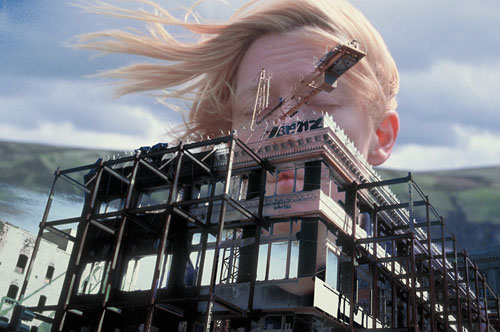

p h o t o c o l l a g e l u c y g r a y

On five evenings beginning Tuesday, April 25, 2005, and running through Saturday, April 29, the 49th San Francisco International Film Festival presented “Big Tilda, a public art project(ion) featuring photocollaged images of the actor Tilda Swinton by the San Francisco photographer (and Archipelagean) Lucy Gray. The images were projected outdoors on the north and south faces of City Hall from 9:00 pm until midnight each evening using high-powered Pani projectors. Archipelago comemmorates the Big Event in word, picture, and song.
I had perfectly nice portraits of Tilda Swinton, but she is so luminous in life and adaptive on screen that I turned to collage to explore her. I wanted to answer her expressions inside the pictures. I have been shooting portraits for nearly fifteen years, and she is the first subject I have found who is strong enough not to ask to be liked. She is one of a very few who is brave enough to be sexual without being minimized, she is beautiful without being classified, she is intelligent without being mean. Physically, she is six feet tall with excellent posture and a commanding, deep voice. She always wears trousers, never wears a dress. When they first meet her many strangers call her “sir.” Tilda uses her authority to hold onto her ambiguity.
Her androgynous face is fluid and so it lends itself naturally to landscape. She is impossible to possess. So much of our culture tells us to believe freedom is found in purchase. I wanted to express another kind of cutting-loose, in creativity, in visual play and pleasure. I tried to explore some of her inner oppenness. The Tilda I met was developing, searching, learning. She sees her life as an adventure which makes her vulnerable in reality. Playing with the question of what is real, I photographed places and people, wove them together in the surreal loom called Photoshop, and then printed them with pigment on watercolor paper to make them seem a little like paintings, that is, fictitious.
Showing these pictures on City Hall in San Francisco seemed to be another obvious extension of their playful and serious nature. I believe deeply in looking at art in public, seeing and thinking and learning in the midst of strangers. That becomes more important as we privatize feelings – as we resist going to the theater, for instance. I am searching for new ways to get people to see things together, out of the house. I believe this is an important political act. But I also think the whole idea that celebrities are larger than life is poked fun at by seeing Tilda nearly a city block long. She is bigger than big, here. And though this is an art exhibit, it is, just like the movies, a show of light that will come and go like a day, hopefully a memorable one. —Lucy Gray

click the image to start the show
Marianne Faithfull, “Broken English,” from Broken English
PJ Harvey, “Big Exit,” from Stories from the City, Stories from the Sea
Handsome Family, “My Sister's Tiny Hands,” from Through the Trees
Paula Frazer and Tarnation, “Pretend,” from Now It's Time
Sleater-Kinney, “Was It a Lie,” from All Hands on the Bad One
Bob Dylan, “Handsome Molly” or “Barbara Allen,” from Live at the Gaslight 1962
Mekons, “Millionaire,” from I Love Mekons
Cat Power, “Come on in My Kitchen,” from All Tomorrow’s Parties 1.1. (curated by Sonic Youth) or “Nude as the News,” from What Would the Community Think
Trailer Bride, “Sapphire Jewel,” from Whine de Lune
Donovan, “Celeste” or “Bert's Blues,” from Sunshine Superman
![]()
Thanks to Audis Husar Gallery and the San Francisco Film Festival for the images shown here.
See David D’Arcy’s review of ‘Big Tilda’ at Artnet
More photos of ‘Big Tilda’ at San Francisco’s Civic Center blog
Lucy Gray’s photographs have appeared in Archipelago:
“Naming the Homeless,” Vol. 4, No. 1
“Balancing Acts: On Ballerinas Who Are Mothers,” Vol. 5, No. 3
and
Susan Garrett, “On Lucy Gray’s Photography,” Vol. 4, No. 1